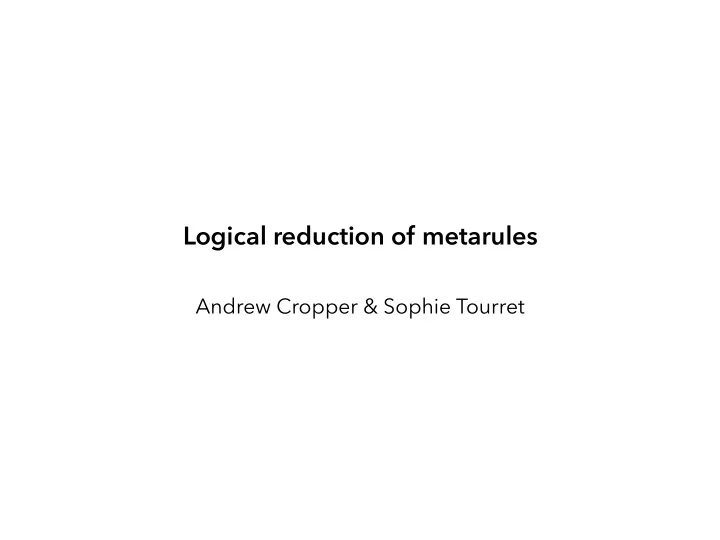

Logical reduction of metarules Andrew Cropper & Sophie Tourret
ILP Examples Learner Computer program Background knowledge
Mode declarations Progol ILASP Aleph XHAIL TILDE …
Metarules Metagol MIL-Hex ∂ ILP ProPPR Clint MOBAL … (almost all neural-ILP approaches)
Metarules P (A,B) ← Q (A,C), R (C,B)
Metarules P (A,B) ← Q (A), R (A,B)
Metarules P (A,B) ← Q (A), R (A,B)
Input % background parent(alice,bob). parent(bob,charlie). % example grandparent(alice,charlie). % metarule P (A,B) ← Q (A,C), R (C,B)
Output % subs Subs = { P \grandparent, Q \parent, R \parent} % program grandparent(A,B) ← parent(A,C), parent(C,B)
Where do we get metarules from?
Completeness Cannot learn grandparent/2 with only P(X) ← Q(X) Efficiency More metarules = larger hypothesis space
Idea: find logically minimal sets
Entailment redundant metarules [Cropper and Muggleton, ILP14] The clause C is entailment redundant in the clausal theory T ∪ {C} when T ⊨ C
Entailment redundancy C1 = p(A,B) ← q(A,B) C2 = p(A,B) ← q(A,B),r(A) C3 = p(A,B) ← q(A,B),r(A),s(B,C)
Entailment redundancy C1 = p(A,B) ← q(A,B) C2 = p(A,B) ← q(A,B),r(A) C3 = p(A,B) ← q(A,B),r(A),s(B,C) {C1} ⊨ {C2,C3}
Entailment reduction P(A,B) ← Q(A,B) P(A,B) ← Q(B,A) P(A,B) ← Q(A,C),R(B,C) P(A,B) ← Q(A,C),R(C,B) P(A,B) ← Q(B,A),R(A,B) ? P(A,B) ← Q(B,A),R(B,A) P(A,B) ← Q(B,C),R(A,C) P(A,B) ← Q(B,C),R(C,A) P(A,B) ← Q(C,A),R(B,C) P(A,B) ← Q(C,A),R(C,B) P(A,B) ← Q(C,B),R(A,C) P(A,B) ← Q(C,B),R(C,A)
Entailment reduction P(A,B) ← Q(A,B) P(A,B) ← Q(B,A) P(A,B) ← Q(B,A) P(A,B) ← Q(A,C),R(B,C) P(A,B) ← Q(A,C),R(C,B) P(A,B) ← Q(B,A),R(A,B) P(A,B) ← Q(B,A),R(B,A) P(A,B) ← Q(B,C),R(A,C) P(A,B) ← Q(B,C),R(C,A) P(A,B) ← Q(C,A),R(B,C) P(A,B) ← Q(C,A),R(C,B) P(A,B) ← Q(A,C),R(C,B) P(A,B) ← Q(C,B),R(A,C) P(A,B) ← Q(C,B),R(C,A)
Entailment reduction problem � C1 = P(A,B) ← Q(A,B) C2 = P(A,B) ← Q(A,B),R(A) C3 = P(A,B) ← Q(A,B),R(A,B) C4 = P(A,B) ← Q(A,B),R(A,B),S(A,B)
Entailment reduction problem � C1 = P(A,B) ← Q(A,B) C2 = P(A,B) ← Q(A,B),R(A) C3 = P(A,B) ← Q(A,B),R(A,B) C4 = P(A,B) ← Q(A,B),R(A,B),S(A,B) {C1} ⊨ {C2,C3,C4}
Entailment reduction problem � C1 = P(A,B) ← Q(A,B) C2 = P(A,B) ← Q(A,B),R(A) C3 = P(A,B) ← Q(A,B),R(A,B) C4 = P(A,B) ← Q(A,B),R(A,B),S(A,B) {C1} ⊨ {C2,C3,C4} father(A,B) ← parent(A,B), male(A) ✖
Derivation redundancy [Cropper and Tourret, ILP18, JELIA19] The clause C is derivationally redundant in the theory T ∪ {C} when T ⊢ C
Derivation redundancy The clause C is derivationally redundant in the theory T ∪ {C} when T ⊢ C SLD-resolution in this work
Derivation redundancy C1 = P(A,B) ← Q(A,B) C2 = P(A,B) ← Q(A,B),R(A) C3 = P(A,B) ← Q(A,B),R(A,B) C4 = P(A,B) ← Q(A,B),R(A,B),S(A,B)
Derivation redundancy C1 = P(A,B) ← Q(A,B) C2 = P(A,B) ← Q(A,B),R(A) C3 = P(A,B) ← Q(A,B),R(A,B) C4 = P(A,B) ← Q(A,B),R(A,B),S(A,B) {C1,C2,C3} ⊢ {C4} father(A,B) ← parent(A,B), male(A) ✔
MLJ Paper We compare subsumption, entailment, and derivation reduction We theoretically show whether infinite fragments of metarules can be logically reduced to finite sets We run the reduction algorithms on finite sets of metarules to identify minimal sets We experimentally compare the learning performance of Metagol when supplied with reduced sets of metarule
Theoretical questions Q . Can we reduce M to a fragment with only two body literals? Q . Can we reduce M to a fragment with finitely many body literals? Q . If M has a finite reduction, what is that fragment?
Idea 1. Generate big sets of metarules 2. Run the reduction algorithms on the sets 3. Study the results.
H am maximum arity a maximum body literals m
Can the connected fragment C 2 ∞ be reduced to two body literals?
Can the connected fragment C 2 ∞ be reduced to two body literals?
Can the connected fragment C 2 ∞ be reduced to two body literals? C 2 ∞ cannot be derivationally reduced to C 22
Can the connected fragment C 2 ∞ be reduced to two body literals? C 2 ∞ cannot be derivationally reduced to a finite fragment!
Derivation reduction of connected fragment
Why not?
Can the Datalog D 2 ∞ fragment be reduced to two body literals?
Can the Datalog D 2 ∞ fragment be reduced to two body literals? D 2 ∞ cannot be derivationally reduced to a finite fragment
Reduction summary
Does it matter? Is there any difference in learning performance when using different reduced sets of metarules?
Trains
Accuracies
Learning times
String transformations
String transformations
Inducing game rules
Inducing game rules
Conclusions New form of logical reduction Negative theoretical results (especially for MIL) Little impact on practical performance
Todo Overcome negative theoretical result Expand results to higher-arities Identify domain-specific sets of metarules Identify optimal sets of metarule Logically reduce BK
Recommend
More recommend